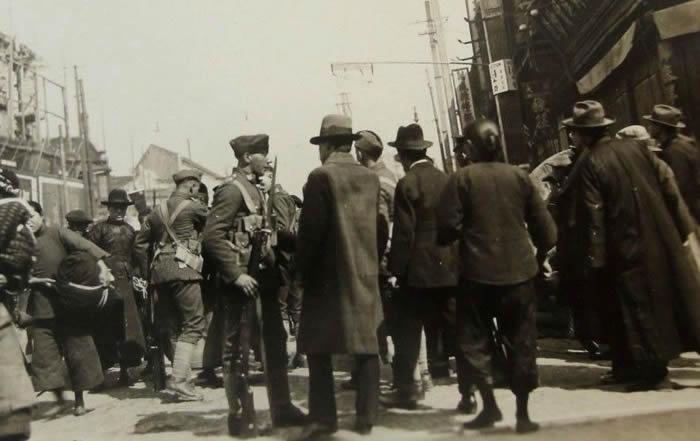 |
| Chiang Kai-shek and his army 1933 |
In 1923 Sun Yat-sen (d. 1925), leader of the Kuomintang (KMT), or Chinese Nationalist Party, then out of power, made an agreement with Adolf Joffe, Soviet representative in China.
It became the basis of an entente between the KMT and the Russian Communist government whereby Russia sent advisers to help Sun and the KMT and allowed Chinese students to go to Russia to study. It also allowed members of the newly formed Chinese Communist Party (CCP) to join the KMT. This entente ushered in what became known as the first united front.
In 1926 the KMT launched a campaign called the Northern Expedition, commanded by Sun's lieutenant Chiang Kai-shek, to oust the warlords and unite China. Its spectacular success led to a power struggle between the Soviet-supported CCP and the anti-CCP faction of the KMT, led by Chiang.
  |
Chiang won the showdown, expelling the Soviet advisers, purging the CCP, and then defeating most of the remaining warlords. Between 1928 and 1937 the KMT ruled from China's new capital, Nanjing (Nanking), under an unstable coalition led by Chiang.
Remnant CCP members fled to the mountains in Jiangsu (Kiangsu) province, where they established the Chinese Soviet Republic with its capital at Ruijin (Juichin). Chiang's new government was too preoccupied with dissident KMT leaders to worry about the CCP between 1928 and 1930, which allowed the CCP to expand to parts of Hunan, Hubei (Hupei), Anhui (Anhwei), and Fujian (Fukien) provinces and increase its army to 120,000 men plus paramilitary units.
Between 1930 and 1934 the Nationalist government launched five encirclement and extermination campaigns against the Communists (First Campaign, from fall 1930 to April 1931; Second Campaign, from February to May 1931; Third Campaign, from July to September 1931; Fourth Campaign, from January to April 1933; and Fifth Campaign, from October 1933 to October 1934).
 |
| soldiers are looking for Communists |
The first four campaigns failed because they were commanded by generals of varying ability and loyalty, because the government simultaneously had to deal with more serious revolts by dissident KMT generals, and because of Japan's attack on Manchuria and Shanghai (1931–32).
Meanwhile, Chiang consolidated his leadership and improved the central government's army with the help of German military advisers. He personally led the 700,000-strong army in the Fifth Campaign and adopted new strategies that were "70 percent political, 30 percent military."
Militarily, he emphasized good training and improved morale for his officers and soldiers. As they advanced, his men constructed forts and blockhouses that blockaded the Communist-ruled areas. The political aspect of his strategies stressed economic reform, rural reconstruction, and neighborhood organization for security.
   |
These measures eliminated many of the abuses that had allowed the Communists to win the loyalty of the people of the contested region. The combination of military success and economic blockade effectively strangled the Communist-controlled land, reducing it to six counties by September 1934.
On October 2 the central Chinese Soviet government headed by Mao Zedong (Mao Tse-tung) and its main army under Zhu De (Chu Teh) decided to abandon Ruijin. They broke through the western sector of the blockade, where a general not loyal to Chiang had not completed building the blockhouses. Thus began the Long March.